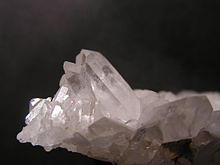Xenomorph

Xenomorph (also allotriomorph ) is a term from mineralogy and denotes minerals that are not present in their crystallographically determined intrinsic shape, i.e. that do not have pronounced crystal faces and the geometry typical for the respective mineral (see also crystal morphology ).
Xenomorphic minerals arise when these are spatially restricted during growth. This is the case, for example, with more or less simultaneous growth of different minerals during the solidification of a rock melt ( magma ), where the individual minerals hinder each other in their growth. As a result, they cannot develop their own shape and are called xenomorphic.
Crystals that have developed their own full shape are called idiomorphic and those that have only partially developed them are called hypidiomorphic . Pseudomorphoses , on the other hand, are minerals that have taken on the external form of another mineral type.
etymology
The term xenomorph is made up of ancient Greek ξένος [xénos] for "stranger" or "foreign" and μορφή [morphé] for "shape" or "form". The synonymous term allotriomorph is derived from the ancient Greek prefix ἄλλοτριος [allótrios] for "foreign (kind)".
literature
- Rudolf Graubner: Lexicon of geology, minerals and rocks . Emil Vollmer Verlag GmbH, Munich 1980, ISBN 3-87876-327-1 , p. 416 .
- Hans Murawski , Wilhelm Meyer : Geological dictionary . 12th edition. Spektrum Akademischer Verlag, Heidelberg 2010, ISBN 978-3-8274-1810-4 , pp. 6 .
Individual evidence
- ^ Hans Murawski, Wilhelm Meyer: Geological dictionary . 12th edition. Spektrum Akademischer Verlag, Heidelberg 2010, ISBN 978-3-8274-1810-4 , pp. 211/18, 213/222 and 233 .
